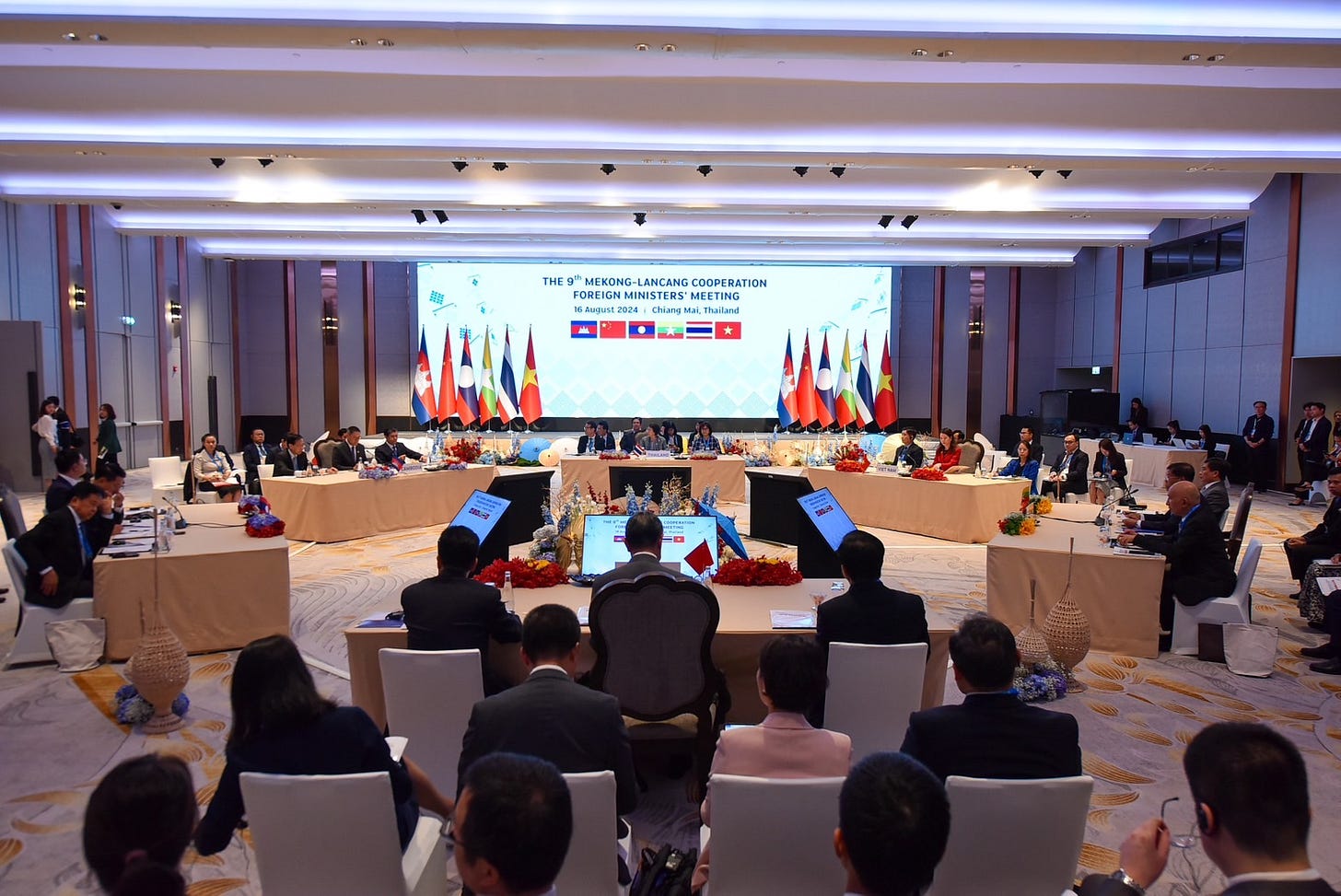Thailand Paetongtarn Shift Dominates Amid China Mekong Engagement
Plus new defense pact talk; Indo-Pacific futures; quiet military warming; simmering sectoral wars; new cross-continental free trade pact; and much, much more.
Dear Readers - thank you for the outpouring of support and feedback for our new podcast launch! We will take that on board as we continue to evolve our ASEAN Wonk product mix amid ongoing engagements. Indeed, we just had a chance to discuss our ASEAN Wonk plans over the past week amid some candid private exchanges with Southeast Asia and Indo-Pacific defense officials on the sidelines of a key security conference in the Pacific Islands.
For those who haven’t already, you can upgrade to a paid subscription for $5 a month/$50 a year below to receive full posts by inserting your email address and then selecting an annual or monthly option. You can visit this page for more on pricing for institutions, groups as well as discounts. For current paid subscribers, please make sure you’re hitting the “view entire message” prompt if it comes up at the end of a post to see the full version.
For this iteration of ASEAN Wonk BulletBrief, we are looking at:
Assessing the geopolitical and geoeconomic significance of Thailand’s new leadership shift and foreign policy implications amid an increasingly China-led subregional mechanism;
Mapping of regional developments, including new defense pact talk and maiden foreign power voyage and coming transition;
Charting evolving geopolitical, geoeconomic and security trends such as Indo-Pacific futures; simmering sectoral wars & cross-border hiccup;
Tracking and analysis of industry developments and quantitative indicators including quiet military warming; new cross-continental free trade agreement; coming green pact and much more!
This Week’s WonkCount: 2,037 words (~10 minutes)
New Defense Pact Talk; Maiden Foreign Power Voyage & Coming Transition

Indo-Pacific Futures; Soft Power Contest & Hard Local Realities
“[T]he best path forward for India would be one of bolstering strategic autonomy politically at home by building capacity, and working through issue-based coalitions of the willing and able abroad to pursue our interests,” India’s former foreign secretary Shivshankar Menon argues in a new forecast on India’s global outlook. The forecast identifies three scenarios based on seven variables: 1) the neighborhood; 2) the US; 3) China-US relations; 4) China’s trajectory; 5) Eurasia; 6) world economy; and 7) world order. (link).
“[T]hat advantage may be shrinking,” warns a new CSIS analysis on how U.S. soft power and influence in Southeast Asia ranks relative to China. The analysis notes that while the United States retains more soft power and popularity than China across most of the region, Beijing is supplementing its growing economic and political clout with soft power exchanges which require more understanding and investment on the part of Washington. The report also includes third countries such as Australia and Japan on indicators like student mobility to go beyond the U.S.-China binary lens (link).
Public and Elite Opinion Towards China and the United States in Southeast Asian States
“The 2025 elections are shaping up to be a rambunctious exercise in democracy on the one hand and deadly competition over power on the other exacerbated by interference from Manila,” argues a report on upcoming polls for the Bangsamoro Autonomous Region in Muslim Mindanao (BARMM) in the southern Philippines published by the Institute for Policy Analysis of Conflict. The report notes while some in the government believe it is more secure to keep the Moro Islamic Liberation Front in power for another election cycle out to 2028, “there are many reasons to question that premise.” (link)
Thailand Paetongtarn Shift Dominates Amid China Mekong Engagement
What’s Behind It
Thailand’s leadership change dominated headlines as Bangkok hosted an August 16 meeting of the China-led Lancang-Mekong Cooperation (LMC), a key piece of ongoing institutional competition astride one of the world’s largest and longest rivers. ASEAN Wonk understands Thai officials had to make last-minute adjustments to the LMC foreign ministers’ meeting amid the removal of Thai Prime Minister Srettha Thavisin by the constitutional court on August 141. Thailand is co-chairing the LMC with China for the 2024-2025 term and the government had earlier touted a prominent role for him at the meet. He was subsequently replaced as premier by Paetongtarn Shinawatra, daughter of controversial ex-premier Thaksin whose family influence has already been clear in some foreign policy areas as noted previously2. Srettha had introduced some notable policies himself in this domain, including a land bridge and soft power.
Select Key August Geopolitical Developments in the Mekong Subregion
Paetongtarn assumes office with a Mekong region in continued flux (see above graphic). More under-the-radar developments this past week alone — such as Laos’ announced deadline for a special force crackdown on the notorious Golden Triangle Special Economic Zone amid giant scam concerns or the publicization of ongoing attempted intensification of U.S.-Cambodia military contacts following from earlier this year — illustrate complex, multifaceted realities at play that involve shifting domestic realities and multiple major powers3. These are in addition to more China-focused stories that dominated the headlines, like the progress on Cambodia’s newly-launched China-backed Funan Techo canal or Foreign Minister Wang Yi’s engagements in Myanmar4.
Why It Matters
A close reading of the ministerial outcomes indicates some of the key contours to watch in its future trajectory (see the originally generated ASEAN Wonk table below on what to watch on specific areas and outcomes. Paying subscribers can also read on for more on what to expect and future implications in the rest of the “Why It Matters” and “Where It’s Headed” sections, along with remaining paid-only sections of the newsletter as usual).











